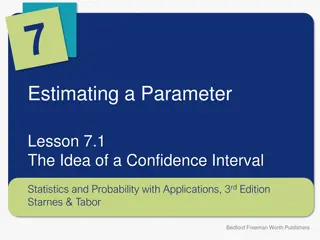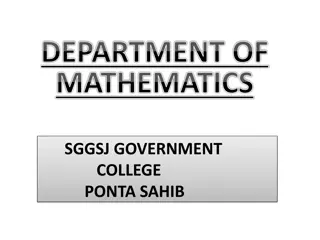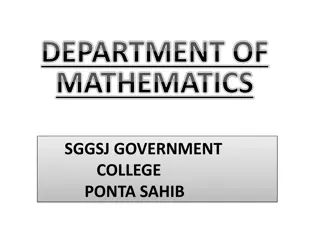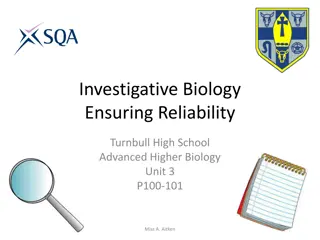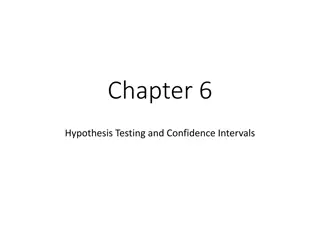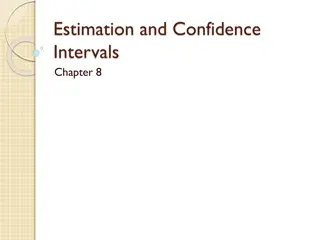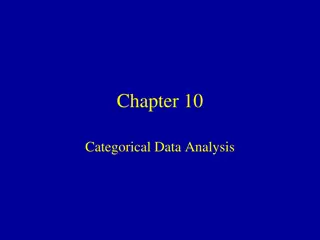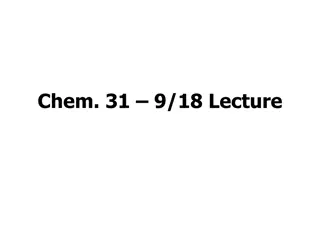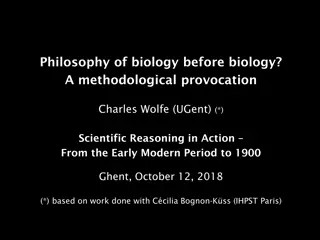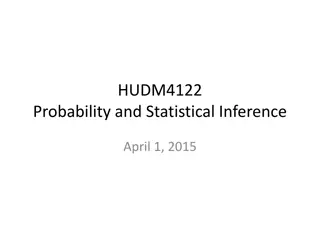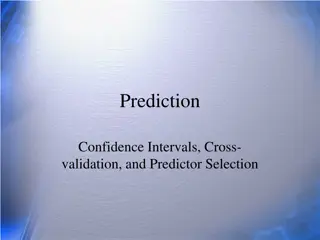Applying 95% Confidence Intervals in Biology
This content explores the concept of 95% confidence intervals in the context of a biology experiment measuring the number of bubbles produced under different lighting conditions. It discusses sample means, population mean variability, and the standard error in relation to sample means. The goal is to determine if the observed differences are statistically significant.
Download Presentation

Please find below an Image/Link to download the presentation.
The content on the website is provided AS IS for your information and personal use only. It may not be sold, licensed, or shared on other websites without obtaining consent from the author.If you encounter any issues during the download, it is possible that the publisher has removed the file from their server.
You are allowed to download the files provided on this website for personal or commercial use, subject to the condition that they are used lawfully. All files are the property of their respective owners.
The content on the website is provided AS IS for your information and personal use only. It may not be sold, licensed, or shared on other websites without obtaining consent from the author.
E N D
Presentation Transcript
Using and Understanding 95% Confidence Intervals in BIOL 1011
100 cm (light off) 100cm (light on) 50cm (light on) 25cm (light on) 12 cm (light on) # of bubbles produced (your bench) 0 3 15 38 49 mean # of bubbles produced (n=6 ) 0.25 4.35 18.65 36.20 51.15
100 cm (light off) 100cm (light on) 50cm (light on) 25cm (light on) 12 cm (light on) # of bubbles produced (your bench) 0 3 15 38 49 mean # of bubbles produced (n= 6 ) 0.25 4.35 18.65 36.20 51.15 are they different?
100 cm (light off) 100cm (light on) 50cm (light on) 25cm (light on) 12 cm (light on) # of bubbles produced (your bench) 0 3 15 38 49 mean # of bubbles produced (n= 6 ) 0.25 4.35 18.65 36.20 51.15 are they different? 100 cm (light off) 100cm (light on) 50cm (light on) 25cm (light on) 12 cm (light on) mean # of bubbles produced (n= 6 ) 0 6.75 20.00 41.65 62.85 100 cm (light off) 100cm (light on) 50cm (light on) 25cm (light on) 12 cm (light on) mean # of bubbles produced (n= 6 ) 1.1 2.25 14.85 22.45 38.35
100 cm (light off) 100cm (light on) 50cm (light on) 25cm (light on) 12 cm (light on) # of bubbles produced (your bench) 0 3 15 38 49 mean # of bubbles produced (n= 6 ) 0.25 4.35 18.65 36.20 51.15 sample means for Bacopa at 50 cm with 100W light 100 cm (light off) 100cm (light on) 50cm (light on) 25cm (light on) 12 cm (light on) mean # of bubbles produced (n= 6 ) 0 6.75 20.00 41.65 62.85 100 cm (light off) 100cm (light on) 50cm (light on) 25cm (light on) 12 cm (light on) mean # of bubbles produced (n= 6 ) 1.1 2.25 14.85 22.45 38.35
sample means vary around the population mean 14.85 18.65 20.00
sample means vary around the population mean 14.85 18.65 20.00 standard error tells us how much a sample mean tends to vary from the population mean
sample means vary around the population mean 14.85 18.65 20.00 standard error tells us how much a sample mean tends to vary from the population mean standard error = standard deviation / n
sample means vary around the population mean 95% of sample means fall within 2 standard errors of the population mean 2SE 2SE 14.85 18.65 20.00 standard error tells us how much a sample mean tends to vary from the population mean standard error = standard deviation / n
sample means vary around the population mean so, an interval of sample mean 2 standard errors is 95% likely to contain the population mean: it s a 95% confidence interval 95% of sample means fall within 2 standard errors of the population mean 2SE 2SE 14.85 18.65 20.00 standard error tells us how much a sample mean tends to vary from the population mean standard error = standard deviation / n
Using 95% confidence intervals to compare two means Calculate standard error (SE) for each mean using standard deviation and n Construct 95% confidence interval for each mean: sample mean 2SE Compare the two intervals: do they overlap? NO YES the means are likely to be significantly different the means are not likely to be significantly different
Mean Age (years) 3.50 3.60 Standard Deviation 0.9 0.7 Location n West End East End 556 442 Does mean age differ between west and east?
Mean Age (years) 3.50 3.60 Standard Deviation 0.9 0.7 Location n West End East End 556 442 Does mean age differ between west and east? Null hypothesis: There is no difference between mean age at west and east ends.
Mean Age (years) 3.50 3.60 Standard Deviation 0.9 0.7 Location n West End East End 556 442 Does mean age differ between west and east? Null hypothesis: There is no difference between mean age at west and east ends. 1. Find standard error for each. 2. Construct 95% confidence intervals for each.
3. Construct graph to visually compare confidence intervals. Do they overlap? 3.7 Maternal Age at Birth of First 3.65 sample means 3.6 3.55 Offspring 3.5 3.45 3.4 error bars (mean 2SE) 3.35 3.3 West End East End Location on Island
3. Construct graph to visually compare confidence intervals. Do they overlap? 3.7 Maternal Age at Birth of First 3.65 3.6 3.55 Offspring 3.5 3.45 3.4 3.35 3.3 West End East End Location on Island The intervals overlap, so we can say that the means are not likely to be different. We will not reject the null hypothesis that the means are not different.




